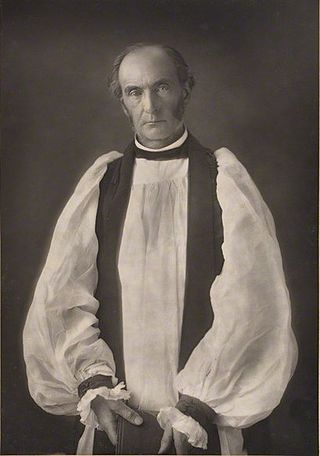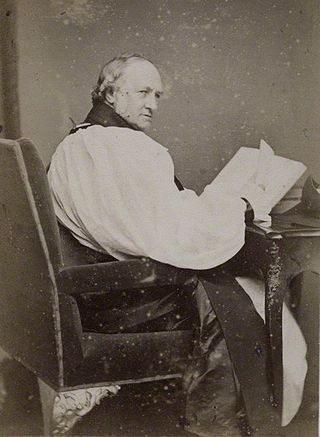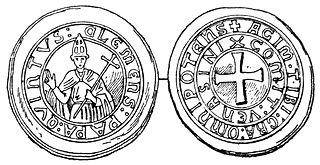Life
Little is known of his early life. In 1452 Walton was made Abbot of Osney, and in 1472 was elected as Archbishop of Dublin, and consecrated in England. In 1478 he managed, through the Irish Parliament, to obtain the restitution of some manors alienated by his predecessors. During his tenure Pope Sixtus IV authorized the re-establishment of the unsuccessful University of Dublin, but the plan was never carried out. [1]
Walton kept out of politics, and was apparently rather easily bullied. He was overshadowed by his suffragan, the quarrelsome and unpopular William Sherwood, Bishop of Meath. In 1474 he failed to impose his will on the Dean and Chapter of St Patrick's Cathedral, Dublin, and was reprimanded by King Edward IV for making the attempt. He was completely unable to control Sir James Keating, the violent and turbulent Prior of the Order of Knights Hospitallers at Kilmainham. When he was replaced as Prior by the English monk Marmaduke Lumley in 1482, Keating had Lumley seized and imprisoned. Despite repeated orders from both Walton and Octavian De Spinellis, the Archbishop of Armagh, Keating refused to release Lumley, who died in prison. [2] Keating himself was eventually removed from office in 1490 for his treason in supporting the claim of the pretender Lambert Simnel, and died soon after. [2]
In 1484, blind and in bad health, he resigned the archbishopric. He retired to his manor of Swords, Dublin. On 17 March 1489, he emerged to preach a sermon for the Feast day of St. Patrick before the Lord Deputy at his former cathedral. He died soon afterwards, leaving bequests to Osney Abbey, where he had hoped to be buried, were his death to have occurred in England. [1]

William Conyngham Plunket, 4th Baron Plunket was Dean of Christ Church Cathedral and Archbishop of Dublin in the Church of Ireland.
Fulk Basset was archbishop of Dublin. He was the elder brother of John de Sandford, who was also Archbishop of Dublin from 1284 to 1290.

Thomas Jones was Archbishop of Dublin and Lord Chancellor of Ireland. He was also Dean of St. Patrick's Cathedral and Bishop of Meath. He was the patrilineal ancestor of the Viscounts Ranelagh.

Marcus Gervais Beresford was the Church of Ireland Bishop of Kilmore, Elphin and Ardagh from 1854 to 1862 and Archbishop of Armagh and Primate of All Ireland from 1862 until his death.
Thomas Lancaster was an English Protestant clergyman, Church of Ireland Archbishop of Armagh from 1568.
Sir Edward Waterhouse (1535–1591) was an English-born Chancellor of the Exchequer of Ireland from 1586 to 1589 and Chief Secretary for Ireland from 1566 to 1567 and again from 1568 to 1569.
Richard de Ferings, was the Archbishop of Dublin.
Walter Fitzsimon or Fitzsimons was a statesman and cleric in Ireland in the reign of Henry VII, who held the offices of Archbishop of Dublin and Lord Chancellor of Ireland.
Robert Wikeford or de Wikeford was an English-born diplomat, lawyer and judge, who became Lord Chancellor of Ireland and Archbishop of Dublin.
Richard Talbot was an English-born statesman and cleric in fifteenth-century Ireland. He was a younger brother of John Talbot, 1st Earl of Shrewsbury. He held the offices of Archbishop of Dublin and Lord Chancellor of Ireland. He was one of the leading political figures in Ireland for more than thirty years, but his career was marked by controversy and frequent conflicts with other statesmen. In particular, the Talbot brothers' quarrel with the powerful Earl of Ormonde was the main cause of the Butler–Talbot feud, which dominated Irish politics for decades, and seriously weakened the authority of the English Crown in Ireland.
John de St Paul, also known as John de St. Pol, John de Owston and John de Ouston, was an English-born cleric and judge of the fourteenth century. He was Archbishop of Dublin 1349–62 and Lord Chancellor of Ireland 1350–56. He had previously been Master of the Rolls in England 1337–40. Apart from a brief period of disgrace in 1340, he enjoyed the confidence of King Edward III. He was described as a zealous supporter of English rule in Ireland, but also as a pragmatic statesman who was willing to conciliate the Anglo-Irish ruling class. He did much to enlarge and beautify Christ Church, Dublin, although virtually no trace of his improvements survive, as they were destroyed by the Victorian rebuilding of the cathedral.
Thomas Minot, also spelt Mynot or Mynyot was an English-born judge and cleric in fourteenth-century Ireland. He was Archbishop of Dublin from 1363 to 1375. He is chiefly remembered for his extensive restoration works to St Patrick's Cathedral, Dublin, and in particular for rebuilding the Cathedral's tower, which is still called Minot's Tower.
John Walton, also John Capellanus was an English Augustinian canon, known as a poet and translator.
Thomas Price (1599–1685) was the Church of Ireland's Archbishop of Cashel.

The medieval University of Dublin was an early unsuccessful attempt to establish a university in Dublin, the capital city of the Lordship of Ireland. Founded in 1320, it maintained an intermittent existence for the next two centuries, but it never flourished, and disappeared for good at the Reformation in Ireland (1534–41). It was located in Saint Patrick's Cathedral, Dublin. It had no connection with the present University of Dublin, better known as Trinity College Dublin, which was founded in 1592.

John Sterne (1660–1745) was an Irish Church of Ireland clergyman, bishop of Dromore from 1713 and then bishop of Clogher from 1717.
Sir James Keating was an Irish cleric and statesman of the fifteenth century. He was Prior of the Irish house of the Knights Hospitallers, which was based at Kilmainham, Dublin, and a member of the Privy Council of Ireland.
Octavian De Spinellis or Ottaviano de Palatio was Archbishop of Armagh from 1478 until 1513.
Randolph Jewett, or Randal Jewett was an English organist and composer. He was a cathedral organist in Dublin, later in Winchester.
Ralph de Norwich (c.1180–1259) was an English-born cleric, judge and Crown servant to King John and King Henry III, much of whose career was spent in Ireland, where he held office as Lord Chancellor of Ireland for several years. He was elected Archbishop of Dublin in 1256, but his election was vetoed by the Pope, on the grounds that despite his clerical office he was essentially a secular official, and too devoted to the King's interests to be a good servant of the Pope.
This page is based on this
Wikipedia article Text is available under the
CC BY-SA 4.0 license; additional terms may apply.
Images, videos and audio are available under their respective licenses.
![]() This article incorporates text from a publication now in the public domain : Lee, Sidney, ed. (1899). "Walton, John (d.1490?)". Dictionary of National Biography . Vol. 59. London: Smith, Elder & Co.
This article incorporates text from a publication now in the public domain : Lee, Sidney, ed. (1899). "Walton, John (d.1490?)". Dictionary of National Biography . Vol. 59. London: Smith, Elder & Co.



